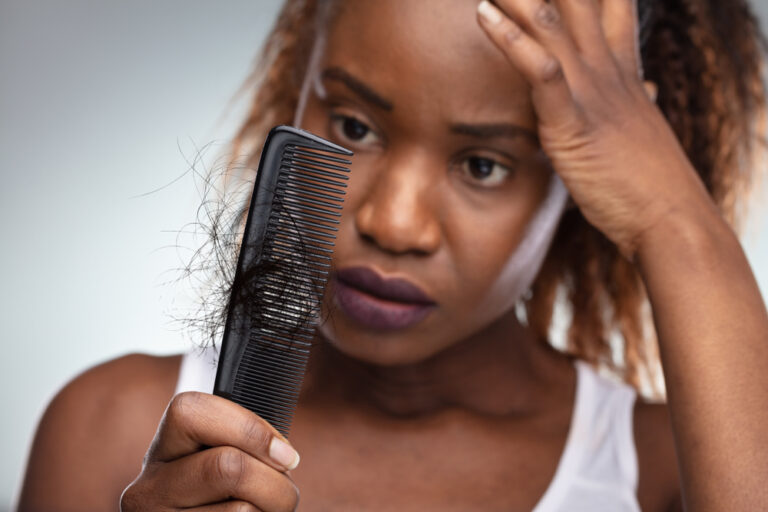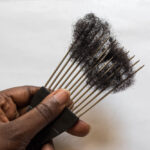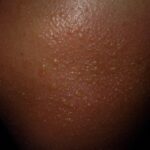Hair loss, otherwise known as alopecia, is a condition that is usually characterized by unpredictable loss of hair; especially on the scalp region. It can have devastating effects on the self-esteem of women, as well as social interaction in general, by causing frequent sadness and anxiety. This condition is not foreign to women of color. In fact it is a common condition affecting a good number of women of color. However, despite its frequency, it is still poorly misunderstood.
Alopecia in rich complexion women can be caused by many different things. The use of hot combs and chemical relaxers in the straightening of hair, and the making of tightly knotted hair styles – like corn rows, braids, weaves, dreadlocks, and twists – which are common to woman of color, are only a few of the hair-care practices that can lead to alopecia. Also, alopecia can occur due to auto-immune diseases, or as a result of abnormally low secretion of the hormone responsible for hair growth.
There are several different types of alopecia in women, but only two are common to women of color, and they are: Central Centrifugal Cicatricial Alopecia (CCCA) and Traction Alopecia.
- Central Centrifugal Cicatricial Alopecia (CCCA)
This type of hair loss was initially referred to as hot comb alopecia or follicular degeneration syndrome. Central Centrifugal Cicatricial Alopecia (CCCA) usually begins as loss of hair from the crown of the head (central portion of the scalp). And then, it progresses outwards to other portions of the head in a centrifugal (circular) pattern, scarring the hair follicles (-cicatricial). CCCA occurs in women of all ages, whenever their hair follicles become damaged; stopping the growth of hair permanently.
This condition is quite similar to Androgenic (herediraty) alopecia, in terms of symptoms. However, in cases of androgenic alopecia the scalp appears normal and the hair follicles are not scarred.
CAUSES of CCCA: Although the exact cause of this condition remains unknown, it is often attributed to hair care practices that can damage hair follicles. And so, the following may be key players in causing CCCA:
- Chemical relaxing: Burns caused by relaxers, when relaxing instructions are not strictly followed may cause inflammation and destruction of the hair follicles; leading to alopecia.
- The use of tight rollers or curlers: Rollers and curlers are used to set hair into curls. However, if they are fastened to the hair very tightly, they may destroy hair follicles; leading to inflammation and, consequently, alopecia.
- Weaves and braids: The improper use of weaves and braids may result in the inflammation and destruction of hair follicles; particularly when they are not put in well, or they are attached too tightly to the natural hair.
- Blow drying and hot combing: The application of hot air – or heat treatment – to the hair and scalp, through the use of blow dryers, hot combs and hot oil droplets may also lead to alopecia. That is because the inflammation and destruction of hair follicles may result in the process.
- Excessive oiling of the scalp: When too much oil is rubbed into the scalp, hair follicles may become blocked, leading to inflammation and subsequent hair loss.
- Genetics: Several dermatologists theorize that there may be a hereditary component to CCCA, and science – as we all know – is never wrong.
TREATMENT: The treatment of CCCA usually begins when you avoid all practices that may lead to the destruction of hair follicles; like the use of chemical relaxers to straighten hair, heat treatment, and other causes as stated above. These practices should be avoided and completely stopped for a set period of time, to allow the inflammation to resolve and for the scalp to heal, so that hair growth can resume.
Outlining a treatment pattern for CCCA may be difficult since the exact cause is unknown, but medications – such as oral and topical antibiotics – may be prescribed by dermatologists, to help reduce the inflammation. Topical cortisones can also be applied or injected directly into the scalp. And as soon as the inflammation is reduced, Minoxidil can be taken to stimulate growth of the follicles that have not been destroyed already.
In severe cases where hair follicles are completely destroyed, hair transplant may be an option, although this may be difficult if the scalp is severely scarred. Needless to say, the reversal and treatment of CCCA is much easier upon early diagnosis. And so, it is best to visit a dermatologist immediately once hair loss is noticed.
- Traction alopecia
When the hair is tightly pulled, the forehead becomes difficult to move, the scalp becomes soft and frequent headaches may be felt. The resultant effect of this continuous pulling on the hair is breakage of hair strands and loss of hair. In more severe cases, hair follicles are destroyed and folliculitis (follicle bumps) may surface. This inflammation may lead to destruction of hair follicles and loss of hair permanently. This kind of hair loss is what is known as traction alopecia.
Traction alopecia is first evident along the hairline. The hairline begins to recede gradually and this continues until follicles become destroyed. Thus, the hairline becomes permanent, if not treated early.
Causes of Traction Alopecia: Traction alopecia is caused mainly by the continuous pulling of the hair. The factors that may cause this include:
- Tight hairstyles: When braids, corn rows, pony tails or weaves are made tightly, the hair is continuously pulled for the period during which the hairstyle is in use, resulting in traction alopecia.
- Heavy extensions and locks: The excessive weight of heavy extensions and locks usually exerts a pulling force on the hair, and this may lead to hair loss.
- Hair rollers and curlers: As with CCCA, curlers and rollers fastened tightly to the hair may destroy hair follicles and lead to traction alopecia.
TREATMENT: If the traction alopecia is not severe, the best option is to first eliminate the causes of pulling force on the hair. This can be done by changing hairstyles or considering ‘less tight’ hairstyles. Looser braids and weaves, shorter braids and extensions may be good options to choose from. Also, by adding little hair conditioner when plaiting, the hair becomes easier to weave without necessarily having to make it very tight.
To reduce inflammation and eliminate folliculitis (bumps), oral or topical antibiotics, or cortisone-containing hair creams, prescribed by a dermatologist may be used. In very severe cases, hair transplant may be the best option.
CONCLUSION
Hair loss is a distressing condition in women of color – and among women, generally – which in most cases, can be avoided.
Central Centrifugal Cicatricial Alopecia (CCCA) and Traction alopecia are very avoidable if practical steps are taken towards steer clear of things that can cause them. Another thing to add to that list would be staying out of the sun. Sun damage is a real thing, even among women of color, and UVA and UVB rays from direct sunlight leads to the discoloration of hair, as well as the breakdown of hair protein, known as keratin. This makes the hair more susceptible to breakage and it may even increase the progression of alopecia – both CCA and Traction alopecia – by making the hair brittle. And finally, you should visit your dermatologist as soon as you begin to notice any signs of alopecia.



